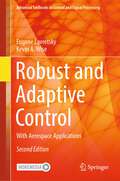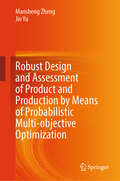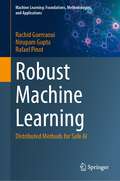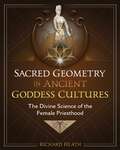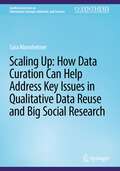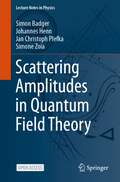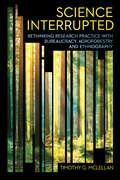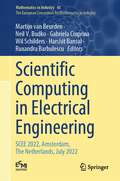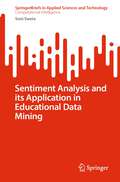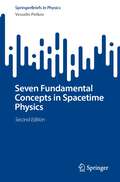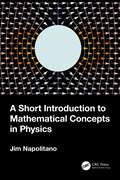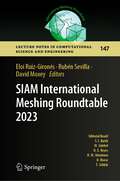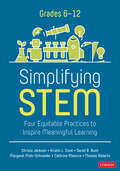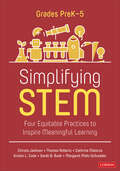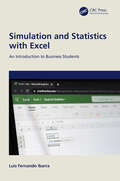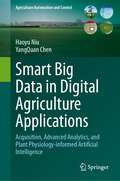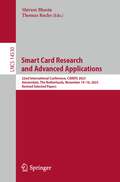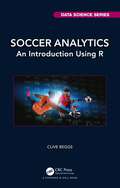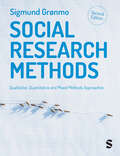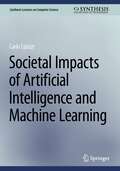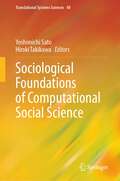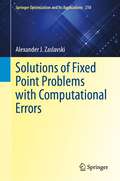- Table View
- List View
Robust and Adaptive Control: With Aerospace Applications (Advanced Textbooks in Control and Signal Processing)
by Eugene Lavretsky Kevin A. WiseRobust and Adaptive Control (second edition) shows readers how to produce consistent and accurate controllers that operate in the presence of uncertainties and unforeseen events. Driven by aerospace applications, the focus of the book is primarily on continuous-time dynamical systems.The two-part text begins with robust and optimal linear control methods and moves on to a self-contained presentation of the design and analysis of model reference adaptive control for nonlinear uncertain dynamical systems. Features of the second edition include:sufficient conditions for closed-loop stability under output feedback observer-based loop-transfer recovery (OBLTR) with adaptive augmentation;OBLTR applications to aerospace systems;case studies that demonstrate the benefits of robust and adaptive control for piloted, autonomous and experimental aerial platforms;realistic examples and simulation data illustrating key features of the methods described; andproblem solutions for instructors and MATLAB® code provided electronically.The theory and practical applications address real-life aerospace problems, being based on numerous transitions of control-theoretic results into operational systems and airborne vehicles drawn from the authors’ extensive professional experience with The Boeing Company. The systems covered are challenging—often open-loop unstable with uncertainties in their dynamics—and thus require both persistently reliable control and the ability to track commands either from a pilot or a guidance computer.Readers should have a basic understanding of root locus, Bode diagrams, and Nyquist plots, as well as linear algebra, ordinary differential equations, and the use of state-space methods in analysis and modeling of dynamical systems. The second edition contains a background summary of linear systems and control systems and an introduction to state observers and output feedback control, helping to make it self-contained.Robust and Adaptive Control teaches senior undergraduate and graduate students how to construct stable and predictable control algorithms for realistic industrial applications. Practicing engineers and academic researchers will also find the book of great instructional value.
Robust Design and Assessment of Product and Production by Means of Probabilistic Multi-objective Optimization
by Maosheng Zheng Jie YuThis book develops robust design and assessment of product and production from viewpoint of system theory, which is quantized with the introduction of brand new concept of preferable probability and its assessment. It aims to provide a new idea and novel way to robust design and assessment of product and production and relevant problems. Robust design and assessment of product and production is attractive to both customer and producer since the stability and insensitivity of a product’s quality to uncontrollable factors reflect its value. Taguchi method has been used to conduct robust design and assessment of product and production for half a century, but its rationality is criticized by statisticians due to its casting of both mean value of a response and its dispersion into one index, which doesn’t characterize the issue of simultaneous optimization of above two independent sub-responses sufficiently for robust design, so an appropriate approach is needed. The preference or role of a response in the evaluation is indicated by using preferable probability as the unique index. Thus, the rational approach for robust design and assessment of product and production is formulated by means of probabilistic multi-objective optimization, which reveals the simultaneous optimization of both mean value of a response and its dispersion in manner of joint probability. Besides, defuzzification and fuzzification measurements are involved as preliminary approaches for robust assessment, the latter provides miraculous treatment for the 'target the best' case flexibly.
Robust Machine Learning: Distributed Methods for Safe AI (Machine Learning: Foundations, Methodologies, and Applications)
by Rachid Guerraoui Nirupam Gupta Rafael PinotToday, machine learning algorithms are often distributed across multiple machines to leverage more computing power and more data. However, the use of a distributed framework entails a variety of security threats. In particular, some of the machines may misbehave and jeopardize the learning procedure. This could, for example, result from hardware and software bugs, data poisoning or a malicious player controlling a subset of the machines. This book explains in simple terms what it means for a distributed machine learning scheme to be robust to these threats, and how to build provably robust machine learning algorithms. Studying the robustness of machine learning algorithms is a necessity given the ubiquity of these algorithms in both the private and public sectors. Accordingly, over the past few years, we have witnessed a rapid growth in the number of articles published on the robustness of distributed machine learning algorithms. We believe it is time to provide a clear foundation to this emerging and dynamic field. By gathering the existing knowledge and democratizing the concept of robustness, the book provides the basis for a new generation of reliable and safe machine learning schemes. In addition to introducing the problem of robustness in modern machine learning algorithms, the book will equip readers with essential skills for designing distributed learning algorithms with enhanced robustness. Moreover, the book provides a foundation for future research in this area.
Sacred Geometry in Ancient Goddess Cultures: The Divine Science of the Female Priesthood
by Richard HeathExamines the ancient cosmic science of the female megalithic astronomers• Describes the shared sacred geometry and astronomy knowledge in the megalithic monuments, temples, and secret calendars of the matrilineal cultures of Malta, Gobekli Tepe, and the Minoans of Crete • Shows how early Christians helped preserve ancient science by encoding it in the rock-cut churches of the Cappadocia region of Turkey • Explains how Greek myths reveal the transition from matriarchy to patriarchy Long before Pythagoras and Plato, before arithmetic and Christianity, there existed matrilineal societies around the Mediterranean, led by women with a sophisticated understanding of astronomy and sacred science. In this detailed exploration, Richard Heath decodes the cosmological secrets hidden by ancient goddess-centered cultures on the island of Malta, at Gobekli Tepe in Turkey, and on the Greek island of Crete. Heath reveals how the female astronomers of Malta built megaliths to study the sun, moon, and planets, counting time as lengths and comparing lengths using geometry. He shows how they encoded their cosmological and astronomical discoveries, their &“astronomy of the goddesses,&” in the geometries of their temples and monuments. Examining Maltese and Cretan artifacts, including secret calendars, he details how the Minoans of Crete transformed Maltese astronomy into a matriarchal religion based upon a Saturnian calendar of 364 days. He also reveals evidence of the precursors of Maltese astronomical knowledge in the monuments of Gobekli Tepe. Looking at the shift from sacred geometry to arithmetic in ancient Mediterranean cultures, the author parallels this change in mindset with the transition from matriarchal to patriarchal cultures. He reveals how Greek myths present a way to see the matriarchal past through patriarchal eyes, detailing how Saturn&’s replacement by Jupiter-Zeus symbolizes the transition from matriarchy to patriarchy. The author examines how the early Christians helped preserve the ancient astronomy of the goddesses, due to its connections to Christ&’s cosmological teachings, by encoding it in the artwork of the rock-cut churches and monasteries of the Cappadocia region of Turkey. Revealing how our planet, with its specific harmonics and geometries within our star system, is uniquely designed to support intelligent life, the author shows how this divine spiritual truth was known to the ancient astronomers.
Scaling Up: How Data Curation Can Help Address Key Issues in Qualitative Data Reuse and Big Social Research (Synthesis Lectures on Information Concepts, Retrieval, and Services)
by Sara MannheimerThis book explores the connections between qualitative data reuse, big social research, and data curation. A review of existing literature identifies the key issues of context, data quality and trustworthiness, data comparability, informed consent, privacy and confidentiality, and intellectual property and data ownership. Through interviews of qualitative researchers, big social researchers, and data curators, the author further examines each key issue and produces new insights about how domain differences affect each community of practice’s viewpoints, different strategies that researchers and curators use to ensure responsible practice, and different perspectives on data curation. The book suggests that encouraging connections between qualitative researchers, big social researchers, and data curators can support responsible scaling up of social research, thus enhancing discoveries in social and behavioral science.
Scattering Amplitudes in Quantum Field Theory (Lecture Notes in Physics #1021)
by Simon Badger Johannes Henn Jan Christoph Plefka Simone ZoiaThis open access book bridges a gap between introductory Quantum Field Theory (QFT) courses and state-of-the-art research in scattering amplitudes. It covers the path from basic definitions of QFT to amplitudes, which are relevant for processes in the Standard Model of particle physics. The book begins with a concise yet self-contained introduction to QFT, including perturbative quantum gravity. It then presents modern methods for calculating scattering amplitudes, focusing on tree-level amplitudes, loop-level integrands and loop integration techniques. These methods help to reveal intriguing relations between gauge and gravity amplitudes and are of increasing importance for obtaining high-precision predictions for collider experiments, such as those at the Large Hadron Collider, as well as for foundational mathematical physics studies in QFT, including recent applications to gravitational wave physics.These course-tested lecture notes include numerous exercises with solutions. Requiring only minimal knowledge of QFT, they are well-suited for MSc and PhD students as a preparation for research projects in theoretical particle physics. They can be used as a one-semester graduate level course, or as a self-study guide for researchers interested in fundamental aspects of quantum field theory.
Science Interrupted: Rethinking Research Practice with Bureaucracy, Agroforestry, and Ethnography (Expertise: Cultures and Technologies of Knowledge)
by Timothy G. McLellanScience Interrupted examines how scientists in China pursue environmental sustainability within the constraints of domestic and international bureaucracies. Timothy G. McLellan offers a theoretical framework for analyzing the formal procedural work of Chinese bureaucracy—work that is overlooked when China scholars restrict their gaze to the informal and interpersonal channels through which bureaucracy is often navigated. Homing in on an agroforestry research organization in southwest China, the author takes the experiences of the organization's staff in navigating diverse international funding regimes and authoritarian state institutions as entry points for understanding the pervasiveness of bureaucracy in contemporary science. He asks: What if we take the tools, sensibilities, and practices of bureaucracies seriously not only as objects of critique but as resources for re-thinking scientific practice? Extending a mode of anthropological research in which ethnography serves as source of theory as well as source of data, Science Interrupted thinks with, and not only against, bureaucracy. McLellan shows that ethnographic engagement with bureaucracy enables us to imagine more democratic and more collaborative modes of scientific practice.
Scientific Computing in Electrical Engineering: SCEE 2022, Amsterdam, The Netherlands, July 2022 (Mathematics in Industry #43)
by Martijn Van Beurden Neil V. Budko Gabriela Ciuprina Wil Schilders Harshit Bansal Ruxandra BarbulescuThis volume comprises selected papers presented at the 14th International Conference on Scientific Computing in Electrical Engineering, SCEE 2022, held in Amsterdam, The Netherlands, in July 2022. The aim of the SCEE 2022 conference was to bring together scientists – mathematicians, electrical engineers, computer scientists, and physicists, from universities and industry – to have in-depth discussions of the latest scientific results in Computational Science and Engineering relevant to Electrical Engineering and to stimulate and inspire active participation of young researchers.This extensive reference work is divided into four parts: Part I Circuit Simulation and Design.- Part II Device Simulation.- Part III Computational Electromagnetics.- Part IV Mathematical and Computational Methods. Each part starts with a general introduction, followed by the respective contributions. The book will appeal to mathematicians and electricalengineers. Further, it introduces algorithm and program developers to recent advances in the other fields, while industry experts will be introduced to new programming tools and mathematical methods.
Sentiment Analysis and its Application in Educational Data Mining (SpringerBriefs in Applied Sciences and Technology)
by Soni SwetaThe book delves into the fundamental concepts of sentiment analysis, its techniques, and its practical applications in the context of educational data. The book begins by introducing the concept of sentiment analysis and its relevance in educational settings. It provides a thorough overview of the various techniques used for sentiment analysis, including natural language processing, machine learning, and deep learning algorithms. The subsequent chapters explore applications of sentiment analysis in educational data mining across multiple domains. The book illustrates how sentiment analysis can be employed to analyze student feedback and sentiment patterns, enabling educators to gain valuable insights into student engagement, motivation, and satisfaction. It also examines how sentiment analysis can be used to identify and address students' emotional states, such as stress, boredom, or confusion, leading to more personalized and effective interventions. Furthermore, the book explores the integration of sentiment analysis with other educational data mining techniques, such as clustering, classification, and predictive modeling. It showcases real-world case studies and examples that demonstrate how sentiment analysis can be combined with these approaches to improve educational decision-making, curriculum design, and adaptive learning systems.
Seven Fundamental Concepts in Spacetime Physics (SpringerBriefs in Physics)
by Vesselin PetkovThe book presents seven fundamental concepts in spacetime physics mostly by following Hermann Minkowski’s revolutionary ideas summarized in his 1908 lecture "Space and Time." These concepts are: spacetime, inertial and accelerated motion in spacetime physics, the origin and nature of inertia in spacetime physics, relativistic mass, gravitation, gravitational waves, and black holes. They have been selected because they appear to be causing most misconceptions and confusion in spacetime physics. This second edition has been revised to include additional clarifications, more detailed elaboration of the arguments and also new material published in the interim.
A Short Introduction to Mathematical Concepts in Physics
by Jim NapolitanoMathematics is the language of physics and yet, mathematics is an enormous subject. This textbook provides an accessible and concise introduction to mathematical physics for undergraduate students taking a one semester course. It assumes the reader has studied a year of introductory physics and three semesters of basic calculus, including some vector calculus, but no formal training in differential equations or matrix algebra. It equips readers with the skills and foundational knowledge they need for courses that follow in classical mechanics, electromagnetism, quantum mechanics, and thermal physics. This book exposes students early on to the kinds of mathematical manipulations they will need in upper-level courses in physics. It can also serve as a useful reference for their further studies. Key features: Accompanied by homework problems and a solutions manual for instructors, available upon qualifying course adoption Bridges the gap between calculus and physics, explaining fundamental mathematics (differentiation, integration, infinite series) in physical terms Explores quick extensions into mathematics useful in physics, not typically taught in math courses, including the Gamma Function, hyperbolic functions, Gaussian integrals, Legendre polynomials, functions of a complex variable, and probability distribution functions
SIAM International Meshing Roundtable 2023 (Lecture Notes in Computational Science and Engineering #147)
by Eloi Ruiz-Gironés Rubén Sevilla David MoxeyThis volume comprises selected papers from the SIAM International Meshing Roundtable Workshop 2023, SIAM IMR 2023, held in Amsterdam, the Netherlands, March 6-9, 2023. The IMR was started by Sandia National Laboratories in 1992 and, since 2021, it has been held under the umbrella of the Society for Industrial and Applied Mathematics (SIAM). The SIAM IMR 2023 was the first in-situ conference to be held since 2019, after two online conferences. It consisted of short courses, technical presentations from keynotes, contributed talks and research notes, a poster session and meshing contest, and discussion panels. The papers in these proceedings present novel contributions that range from theoretical advances to technical applications in engineering, geometric modeling, computer graphics, visualization, and machine learning.
Simplifying STEM [6-12]: Four Equitable Practices to Inspire Meaningful Learning (Corwin Mathematics Series)
by Christa Jackson Kristin L. Cook Sarah B. Bush Margaret J. Mohr-Schroeder Cathrine Maiorca Oliver RobertsStart, focus, or extend your integrated STEM education journey with an authentic interdisciplinary perspective! In response to calls for active STEM learning that builds students’ agency and sense of belonging, teachers and leaders are being encouraged more and more to equitably implement integrated STEM instruction. This practical guidebook is designed to help educators create integrated STEM learning experiences that are inclusive for all students and allows them to experience STEM as scientists, innovators, mathematicians, creators, engineers, and technology experts! Addressing the STEM status quo and promoting inclusiveness in STEM fields, the authors center their work around the Equity-Oriented Conceptual Framework for STEM Literacy, which provides high-quality integrated strategies to connect students′ lived experiences to STEM learning. Simplifying STEM provides a ground-breaking model of the four Integrated STEM Practices (ISPs) to ensure coherent and aligned teaching across disciplines through authentic opportunities to meaningfully engage students. Learn how to simplify STEM with these four equitable practices to inspire deep learning Use critical and creative thinking to seek solutions Collaborate and use appropriate tools to engage in iterative design Communicate solutions based on evidence and data Recognize and use structures in real-world systems Including a STEM planning guide as well as instructional strategies and assessments for standard alignment, this is an essential resource for any educator seeking to empower their students with meaningful STEM learning experiences. The book includes an online implementation toolkit to give educators opportunities for powerful professional development built on collaboration and connection.
Simplifying STEM [6-12]: Four Equitable Practices to Inspire Meaningful Learning (Corwin Mathematics Series)
by Christa Jackson Kristin L. Cook Sarah B. Bush Margaret J. Mohr-Schroeder Cathrine Maiorca Oliver RobertsStart, focus, or extend your integrated STEM education journey with an authentic interdisciplinary perspective! In response to calls for active STEM learning that builds students’ agency and sense of belonging, teachers and leaders are being encouraged more and more to equitably implement integrated STEM instruction. This practical guidebook is designed to help educators create integrated STEM learning experiences that are inclusive for all students and allows them to experience STEM as scientists, innovators, mathematicians, creators, engineers, and technology experts! Addressing the STEM status quo and promoting inclusiveness in STEM fields, the authors center their work around the Equity-Oriented Conceptual Framework for STEM Literacy, which provides high-quality integrated strategies to connect students′ lived experiences to STEM learning. Simplifying STEM provides a ground-breaking model of the four Integrated STEM Practices (ISPs) to ensure coherent and aligned teaching across disciplines through authentic opportunities to meaningfully engage students. Learn how to simplify STEM with these four equitable practices to inspire deep learning Use critical and creative thinking to seek solutions Collaborate and use appropriate tools to engage in iterative design Communicate solutions based on evidence and data Recognize and use structures in real-world systems Including a STEM planning guide as well as instructional strategies and assessments for standard alignment, this is an essential resource for any educator seeking to empower their students with meaningful STEM learning experiences. The book includes an online implementation toolkit to give educators opportunities for powerful professional development built on collaboration and connection.
Simplifying STEM [PreK-5]: Four Equitable Practices to Inspire Meaningful Learning (Corwin Mathematics Series)
by Christa Jackson Oliver Roberts Cathrine Maiorca Kristin L. Cook Sarah B. Bush Margaret J. Mohr-SchroederStart, focus, or extend your integrated STEM education journey with an authentic interdisciplinary perspective! In response to calls for active STEM learning that builds students’ agency and sense of belonging, teachers and leaders are being encouraged more and more to equitably implement integrated STEM instruction. This practical guidebook is designed to help educators create integrated STEM learning experiences that are inclusive for all students and allows them to experience STEM as scientists, innovators, mathematicians, creators, engineers, and technology experts! Addressing the STEM status quo and promoting inclusiveness in STEM fields, the authors center their work around the Equity-Oriented Conceptual Framework for STEM Literacy, which provides high-quality integrated strategies to connect students′ lived experiences to STEM learning. Simplifying STEM provides a ground-breaking model of the four Integrated STEM Practices (ISPs) to ensure coherent and aligned teaching across disciplines through authentic opportunities to meaningfully engage students. Learn how to simplify STEM with these four equitable practices to inspire deep learning Use critical and creative thinking to seek solutions Collaborate and use appropriate tools to engage in iterative design Communicate solutions based on evidence and data Recognize and use structures in real-world systems Including a STEM planning guide as well as instructional strategies and assessments for standard alignment, this is an essential resource for any educator seeking to empower their students with meaningful STEM learning experiences. The book includes an online implementation toolkit to give educators opportunities for powerful professional development built on collaboration and connection.
Simplifying STEM [PreK-5]: Four Equitable Practices to Inspire Meaningful Learning (Corwin Mathematics Series)
by Christa Jackson Oliver Roberts Cathrine Maiorca Kristin L. Cook Sarah B. Bush Margaret J. Mohr-SchroederStart, focus, or extend your integrated STEM education journey with an authentic interdisciplinary perspective! In response to calls for active STEM learning that builds students’ agency and sense of belonging, teachers and leaders are being encouraged more and more to equitably implement integrated STEM instruction. This practical guidebook is designed to help educators create integrated STEM learning experiences that are inclusive for all students and allows them to experience STEM as scientists, innovators, mathematicians, creators, engineers, and technology experts! Addressing the STEM status quo and promoting inclusiveness in STEM fields, the authors center their work around the Equity-Oriented Conceptual Framework for STEM Literacy, which provides high-quality integrated strategies to connect students′ lived experiences to STEM learning. Simplifying STEM provides a ground-breaking model of the four Integrated STEM Practices (ISPs) to ensure coherent and aligned teaching across disciplines through authentic opportunities to meaningfully engage students. Learn how to simplify STEM with these four equitable practices to inspire deep learning Use critical and creative thinking to seek solutions Collaborate and use appropriate tools to engage in iterative design Communicate solutions based on evidence and data Recognize and use structures in real-world systems Including a STEM planning guide as well as instructional strategies and assessments for standard alignment, this is an essential resource for any educator seeking to empower their students with meaningful STEM learning experiences. The book includes an online implementation toolkit to give educators opportunities for powerful professional development built on collaboration and connection.
Simulation and Statistics with Excel: An Introduction to Business Students
by Luis Fernando IbarraThe use of simulation techniques has increased in importance in recent history, and simulation activities are an important resource for advanced preparation for the organization and execution of events. When formal mathematics is not enough, simulation may be the only option capable of approximating solutions. Simulation and Statistics with Excel: An Introduction to Business Students offers a non-rigorous and practical tour of the simulation procedure on computers, using a versatile and accessible resource, the Microsoft Excel spreadsheet. This book covers the concepts essential to understanding the basic principles and approaches of statistical simulation, allowing for the study of complex systems. Aimed at students in business and operational research beginning to use simulation as an instrument for understanding existing or proposed processes, this book will lay solid foundations in understanding simulation experimentation.Key Features: Provides a basis to understand the approaches and principles of simulator experiments. Uses a universal and easily accessible resource. Introduces simple examples to teach the fundamentals of simulation.
Smart Big Data in Digital Agriculture Applications: Acquisition, Advanced Analytics, and Plant Physiology-informed Artificial Intelligence (Agriculture Automation and Control)
by Haoyu Niu YangQuan ChenIn the dynamic realm of digital agriculture, the integration of big data acquisition platforms has sparked both curiosity and enthusiasm among researchers and agricultural practitioners. This book embarks on a journey to explore the intersection of artificial intelligence and agriculture, focusing on small-unmanned aerial vehicles (UAVs), unmanned ground vehicles (UGVs), edge-AI sensors and the profound impact they have on digital agriculture, particularly in the context of heterogeneous crops, such as walnuts, pomegranates, cotton, etc. For example, lightweight sensors mounted on UAVs, including multispectral and thermal infrared cameras, serve as invaluable tools for capturing high-resolution images. Their enhanced temporal and spatial resolutions, coupled with cost effectiveness and near-real-time data acquisition, position UAVs as an optimal platform for mapping and monitoring crop variability in vast expanses. This combination of data acquisition platforms and advanced analytics generates substantial datasets, necessitating a deep understanding of fractional-order thinking, which is imperative due to the inherent “complexity” and consequent variability within the agricultural process. Much optimism is vested in the field of artificial intelligence, such as machine learning (ML) and computer vision (CV), where the efficient utilization of big data to make it “smart” is of paramount importance in agricultural research. Central to this learning process lies the intricate relationship between plant physiology and optimization methods. The key to the learning process is the plant physiology and optimization method. Crafting an efficient optimization method raises three pivotal questions: 1.) What represents the best approach to optimization? 2.) How can we achieve a more optimal optimization? 3.) Is it possible to demand “more optimal machine learning,” exemplified by deep learning, while minimizing the need for extensive labeled data for digital agriculture? This book details the foundations of the plant physiology-informed machine learning (PPIML) and the principle of tail matching (POTM) framework. It is the 9th title of the "Agriculture Automation and Control" book series published by Springer.
Smart Card Research and Advanced Applications: 22nd International Conference, CARDIS 2023, Amsterdam, The Netherlands, November 14–16, 2023, Revised Selected Papers (Lecture Notes in Computer Science #14530)
by Shivam Bhasin Thomas RocheThis book constitutes the proceedings of the 22nd International Conference on Smart Card Research and Advanced Applications, CARDIS 2023, held in Amsterdam, The Netherlands, during November 14–16, 2023.The 13 full papers presented in this volume were carefully reviewed and selected from 28 submissions. They were organized in topical sections as follows: fault attacks; side-channel analysis; smartcards & efficient Implementations; and side-channel & neural networks.
Soccer Analytics: An Introduction Using R (Chapman & Hall/CRC Data Science Series)
by Clive BeggsSports analytics is on the rise, with top soccer clubs, bookmakers, and broadcasters all employing statisticians and data scientists to gain an edge over their competitors.Many popular books have been written exploring the mathematics of soccer. However, few supply details on how soccer data can be analysed in real-life. The book addresses this issue via a practical route one approach designed to show readers how to successfully tackle a range of soccer related problems using the easy-to-learn computer language R. Through a series of easy-to-follow examples, the book explains how R can be used to: Download and edit soccer data Produce graphics and statistics Predict match outcomes and final league positions Formulate betting strategies Rank teams Construct passing networks Assess match play Soccer Analytics: An Introduction Using R is a comprehensive introduction to soccer analytics aimed at all those interested in analysing soccer data, be they fans, gamblers, coaches, sports scientists, or data scientists and statisticians wishing to pursue a career in professional soccer. It aims to equip the reader with the knowledge and skills required to confidently analyse soccer data using R, all in a few easy lessons.
Social Research Methods: Qualitative, Quantitative and Mixed Methods Approaches
by Sigmund GronmoFraming research as the process of asking and answering questions, this book demonstrates how to identify good research questions and how to structure and explore them successfully. Whether you are just beginning your research journey or are a seasoned traveller, it helps you: • Decide what you want to achieve with your research • Know what options you have to explore your goals • Navigate the nuances of different research approaches • Understand the decisions of other researchers • Choose what path best suits your project. Through real-life examples demonstrating different types of research, the book introduces qualitative, quantitative, and mixed methods approaches so you can compare different methods at every stage of the research process, from initial idea and design to data collection and analysis. This new edition includes new chapters on collecting and analysing mixed methods data, and additional content on qualitative data analysis. New examples reflect the cultural and global diversity of social research, and extra visual aids and summaries support understanding of key research concepts and stages. The book is accompanied by an online teaching guide, including videos, additional case studies, annotated articles, and critical thinking exercises.
Social Research Methods: Qualitative, Quantitative and Mixed Methods Approaches
by Sigmund GronmoFraming research as the process of asking and answering questions, this book demonstrates how to identify good research questions and how to structure and explore them successfully. Whether you are just beginning your research journey or are a seasoned traveller, it helps you: • Decide what you want to achieve with your research • Know what options you have to explore your goals • Navigate the nuances of different research approaches • Understand the decisions of other researchers • Choose what path best suits your project. Through real-life examples demonstrating different types of research, the book introduces qualitative, quantitative, and mixed methods approaches so you can compare different methods at every stage of the research process, from initial idea and design to data collection and analysis. This new edition includes new chapters on collecting and analysing mixed methods data, and additional content on qualitative data analysis. New examples reflect the cultural and global diversity of social research, and extra visual aids and summaries support understanding of key research concepts and stages. The book is accompanied by an online teaching guide, including videos, additional case studies, annotated articles, and critical thinking exercises.
Societal Impacts of Artificial Intelligence and Machine Learning (Synthesis Lectures on Computer Science)
by Carlo LipizziThis book goes beyond the current hype of expectations generated by the news on artificial intelligence and machine learning by analyzing realistic expectations for society, its limitations, and possible future scenarios for the use of this technology in our current society. Artificial Intelligence is one of the top topics today and is inflating expectations beyond what the technology can do in the foreseeable future. The future cannot be predicted, but the future of some elements of our society, such as technology, can be estimated. This book merges the modeling of human reasoning with the power of AI technology allowing readers to make more informed decisions about their personal or financial decisions or just being more educated on current technologies. This book presents a model that sketches potential future scenarios based on a discussion of the expectations today, the analysis of the current gap in the literature, and a view of possible futures in terms of technology and use cases. Specifically, this book merges literature on the technology aspects, the sociological impacts, and philosophical aspects.
Sociological Foundations of Computational Social Science (Translational Systems Sciences #40)
by Yoshimichi Sato Hiroki TakikawaThis book provides solid sociological foundations to computational social science (CSS). CSS is an emerging research field, and many books with those words in the title are on the market. However, CSS has not become mainstream in sociology, for which there are two reasons. First, CSS does not necessarily solve major research questions in sociology. Second, its sociological foundations are weak. These two reasons are interrelated—that is, CSS cannot solve major research questions because its sociological foundations are weak. Thus, even if it tries to solve those questions, its approaches seem to mainstream sociologists to miss the point. To resolve that shortcoming, this book fills the gap between CSS and sociology, shows that CSS can solve major research questions in sociology, and advances sociology by introducing to it theories and methodologies of CSS.
Solutions of Fixed Point Problems with Computational Errors (Springer Optimization and Its Applications #210)
by Alexander J. ZaslavskiThe book is devoted to the study of approximate solutions of fixed point problems in the presence of computational errors. It begins with a study of approximate solutions of star-shaped feasibility problems in the presence of perturbations. The goal is to show the convergence of algorithms, which are known as important tools for solving convex feasibility problems and common fixed point problems.The text also presents studies of algorithms based on unions of nonexpansive maps, inconsistent convex feasibility problems, and split common fixed point problems. A number of algorithms are considered for solving convex feasibility problems and common fixed point problems. The book will be of interest for researchers and engineers working in optimization, numerical analysis, and fixed point theory. It also can be useful in preparation courses for graduate students. The main feature of the book which appeals specifically to this audience is the study of the influence of computational errorsfor several important algorithms used for nonconvex feasibility problems.
